28-Days-to-Lean Meal Plan
With the right plan and the right discipline, you can get seriously shredded in just 28 days.
Read articleThere’s nothing more eye-catching to the weight-trained eye than a pair of well-toned, well-defined biceps. Maybe that’s because the arms are one of the few bodyparts that are often on display. It is socially acceptable, after all, to wear sleeveless dresses in a way that, say, wearing midriff-revealing garments just isn’t.
But building sculpted biceps isn’t always easy, and without the right training program you could be selling yourself short. So check out this comprehensive piece on everything biceps and get ready to show off when you shed your long sleeves this summer.
ANATOMY LESSON
The biceps muscle consists of two heads, both of which originate on the shoulder blade and run under the delt muscle, emerging at the upper arm. The long, or outer, head of the biceps is responsible for the peak that many men and some women can achieve through training. The short, or inner, head, provides shape on the inside of the arm. Both converge on the same tendon, which attaches to the forearm bones just below the elbow. That should give you some clue as to the muscle’s main function: flexion of the elbow (a.k.a. bending the arm at the elbow).
KNOW YOUR BI’S
In order to build an incredible set of arms, you need to know more than simply how to curl a dumbbell. Here, we answer some of the more common questions concerning how to properly train biceps.
How often should I train biceps?
Most people train biceps once a week. However, sticking with the same split for the rest of your life is a sure way to watch your progress sputter, if not come to a screeching halt altogether. Since the biceps are in your crosshairs right now, consider bumping up your training frequency by adding another biceps day to your split.
Should I train biceps alone?
The larger the amount of muscle that you target with each workout, the better the growth-hormone response. Since the arm muscles are too small to cause a real boost in GH levels, your body relies particularly heavily on growth hormone to assist with gains in muscle size and strength and to reduce body fat. So it’s fine to train biceps with triceps, but only if you’re also training a major muscle group on that same day.
What’s the best number of total sets when training biceps?
Between 6 and 12 sets per workout, depending on how many exercises you choose to do. You could do the typical 2-4 exercises with 3 sets each or you could choose to do fewer exercises for more total sets per exercise.
What’s the best rep range?
Exercise science tells us that the best rep range for building muscle is 8-12 reps. That goes for every muscle group. However, that doesn’t mean that you want to do 8-12 reps every single workout. Use 8-12 reps as your base rep range and occasionally mix it up by going as low as 5-6 with heavier weights and as high as 15-20 reps with lighter weight.
BUMP UP THE INTENSITY
Intensity training techniques can be valuable tools in your program. Here are a few to try.
For dumbbell curls and machine exercises:
Try adding a drop set. On the last set of each exercise, hit muscle failure, then reduce the weight by 20-30% and continue lifting until you hit failure again.
For barbell exercises:
Do the rest-pause technique. Again on the last set of the exercise, reach muscle failure, but instead of reducing weight, reduce the rest period. Take a 10-15 second break before eking out a few more reps.
Also try supersets:
For biceps, those would be called compound sets, or two exercises for same muscle group performed back-to-back. Pick any two exercises, ideally those in which you don’t risk losing your station if you’re at the gym. Do one set of the first exercise, rest and then go immediately into the other exercise, alternating until you’ve completed all sets for both exercises. Compound sets are a great way to get better results in less time, stimulating muscle growth while also bumping up fat loss.
EXERCISE SELECTION
Here’s a little secret: There’s really only one exercise for training biceps. It’s called the curl, and no matter how you dress it up, it involves holding a weight in your hand and bending your elbow to bring that weight up. However, some types of curls can be classified more as mass-building moves, while others can be classified more as muscle-shaping. Sure, there’s some crossover, but for the most part, that’s how we’ve divided the exercises for you to choose from. When putting together a workout, make sure to pick one or two exercises from the Builder list to perform first, then follow that up with two exercises from the Shaper list, making sure that one of them hits the long (outer) head more.
GROUP 1 BUILDERS
These exercises allow you to hit both heads of the biceps evenly. Select 1 or 2 exercises from this list to be performed first in your workout.
Recommendations Exercises:
Standing Barbell Curl
Seated Barbell Curl
Standing EZ-bar Curl
Preacher Curl
Standing Dumbbell Curl
Seated Dumbbell Curl
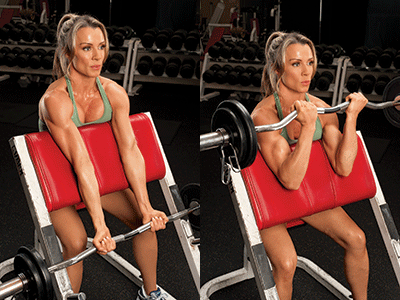
Preacher Curl
● Sit in a preacher curl bench and grab an EZ-curl bar, palms facing up, with your hands on the inside curves of the bar.
● Keep your shoulders pulled back and your chest up.
● Curl the weight up to your shoulders, squeezing for a two-count at the top.
● Lower the weight to the starting position and repeat.
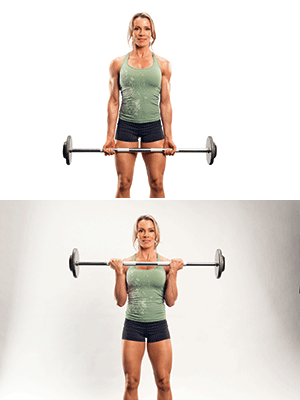
Standing Barbell Curl
● Stand holding a straight bar, palms facing forward, with your hands slightly wider than shoulder width apart.
● Keep your back straight and chest up.
● Curl the weight up to your shoulders and squeeze at the top of the movement.
● Lower the weight slowly and repeat.
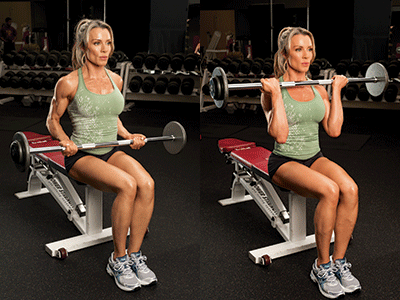
Seated Barbell Curl
● Sit on a bench with your feet flat on the floor. Rest the barbell on your thighs.
● Hold the barbell with an underhand grip, ensuring your hands are shoulder-width apart.
● Keeping your back straight, curl the weight up by bringing your hands toward your shoulders.
● Lower the weight back to the start position and repeat for reps.
GROUP 2 SHAPERS
These exercises limit the ability to cheat and/or focus more on one head than the other. Select two exercises from this list, making sure one of them focuses on the outer head.
Recommended Exercises:
(overall focus):
Incline Dumbbell Curl
Concentration Curl
EZ-bar Cable Curl
Straight Bar Cable Curl
Cable Single-arm Curl
High Cable Curl
(outer head focus):
Behind-the-back Cable Curl
Dumbbell Hammer Curl
Rope Hammer Curl
Reverse-grip Barbell Curl
Reverse-grip Cable Curl
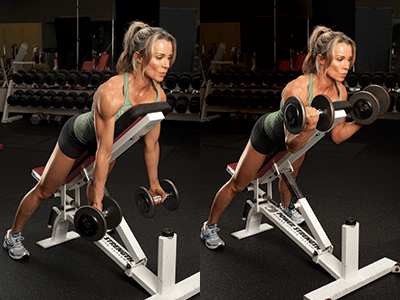
Prone Incline Dumbbell Curl
● Set an adjustable bench to a 45-degree angle.
● Lie face-down on the bench with your chest pressed firmly against the pad and your head above the top of the seatback.
● Letting your arms hang on either side of the bench, hold a set of dumbbells with an underhand grip.
● Raise the dumbbells up toward your shoulders.
● Squeeze, then slowly lower the dumbbells back to the start position.
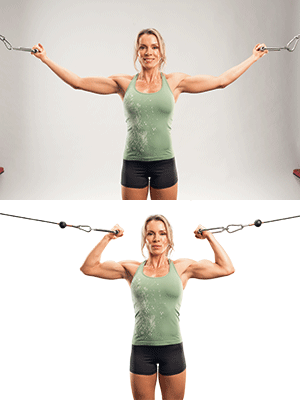
High Cable Curl
● Stand in the middle of a cable pulley station, holding a D-grip handle in an underhand grip in each hand. Your arms should be about parallel to the floor.
● Keeping your upper arms stationary, curl the handles toward your shoulders.
● Hold for a moment at the top, then return slowly to the start position.
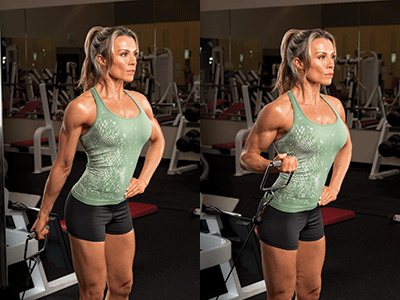
Behind-the-Back Cable Curl
● Attach a D-grip handle to a low pulley and hold with an underhand grip.
● Stand slightly to the left and in front of the pulley with your legs in a staggered stance.
● Extend your arm back behind your body at about a 45-degree angle.
● Curl the weight toward your shoulder, keeping your upper arm locked in the 45-degree position.
● Return slowly to the start position.
CHOOSE YOUR WEAPON
Although the curl is the main exercise to use for training biceps, there are many attachments to choose from when you are using cables. Here’s a primer on what to use and why to use them.
EZ-curl bar: Allows you to have more of a neutral grip. The more neutral the grip, the more involvement you get from the long head of the biceps, which is the one that gives you the best peak. It’s called EZ because it’s easier on the wrist.
Straight bar: Allows you to use a closer grip, which puts more stress on the outer head of the biceps.
D-handle: Essentially a dumbbell for cable exercise. Cables provide constant tension on the muscle, whereas with free weights there are certain areas in the range of motion when you’re not putting stress on the muscle.
Rope: Use this to get a true neutral grip, putting the most emphasis on the outer head of the biceps.
Photography by Ian Logan